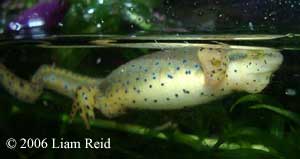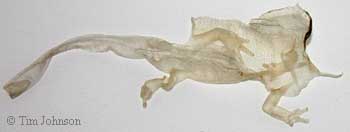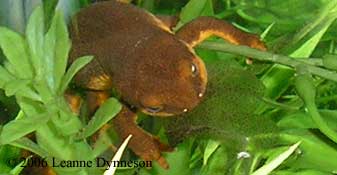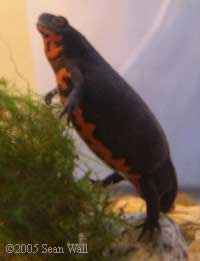CC FAQ Pages
Other Resources
Health and Behavior FAQ
Why won't my newt go in the water?
First, be sure that your newt is an aquatic species. Some, such as Tylototriton shanjing, are not supposed to live in water. If your aquatic newt is not going in the water, it is usually caused by one or more of the following:
- Illness. Sometimes sick newts head for land.
- Stress. Stress can be caused by other animals in the water, being in a new environment, too much handling, a current in the water, temperature too high, etc.
- Bad water. Use a product that removes chloramine. Remove uneaten food promptly. Check the ammonia level, especially if the tank is new. Keep the temperature below 727deg;F (22°C), even cooler if possible.
- Habit. Sometimes a newt just gets in the habit of living on land and is reluctant to enter the water, which is a strange new environment.
- Youth. Juvenile newts of many species tend to be more terrestrial (usually the first year or two after they metamorphose). If your newt is very small (under 3 inches) this may be a factor.
- Nocturnal habits. Some newts enter the water at night and stay out during the day.
- Pecking order. The dominant newt may stay in the water, causing the smaller one to stay out. Since firebelly newts are not very aggressive or territorial, it should be possible to get them into the water.
How can I get my newt to go into the water?
Aquatic newts are easier to care for, grow faster, and are generally more healthy than newts that stay on land. Obviously, this does not apply to species that are naturally terrestrial. To encourage an aquatic newt to go into the water, try the following.
- Test the water to make sure there is nothing wrong with it. See Water Quality FAQs.
- Give it a few days to acclimate to its new surroundings. Do not handle it, keep the lights off, and generally do everything you can to reduce its stress level.
- Get rid of any fish or other animals in the water.
- Keep it cooler. The least stressful temperatures for most newts are 50-68°F.
- Put the newt(s) in a shallow water setup (1-2 inches of water). Provide lots of plants in the water, and lots of wading areas and resting places just below the water surface. Because the water is so shallow, skip the filter and gravel, just use an airstone and remove debris daily with a turkey baster or siphon. Once the newt has adjusted to water, raise the water level.
- Spray the land and newt with water daily.
- Put some tempting food in the water. Live blackworms will stay alive in the water until eaten.
One of my paddletail newts keeps attacking the other. The smaller one is not eating well. What is going on?
Paddletail newts (Pachytriton labiatus) are aggressive and territorial. To be healthy in the long-term, the bullied one will need to be kept in a separate tank. Other territorial newts include the warty newts (Paramesotriton species).
Does my newt/salamander need a friend? Are they social?
No. Salamanders are not social animals. They are perfectly happy alone, and do not need another salamander to keep them company.

My newt just puffed itself up and acted like it was dead, but now it's acting OK again. Is this normal?
This is normal (see photo). It is believed that newts may do this to stretch their skin before shedding, but it is not known for certain.
My newt's skin is coming off. Is that normal?
If the skin is coming off all in one piece, it's just normal shedding. It is also normal for the newt (or another newt in the tank) to eat the shed skin. However, if the skin comes off in small, flakey pieces, or if the skin gets stuck around the animal's abdomen or legs during shedding, these can be signs of illness.
 Shed skin from a Cynops ensicauda. |
 It is normal for a newt to eat its own shed skin. |
What does newt "poop" look like?
Usually, any bits of brown material in the tank are likely to be it. Occasionally, you will see an intact "pellet" before it disintegrates.

Example of newt scat from an adult Neurergus strauchii.
My firebelly newt's toe/foot/leg is gone! What happened and what should I do?
There are two possibilities. A tankmate could have bitten off the leg. In this case, remove the offending tankmate. More commonly, a limb can be eroded away due to infection. This is common in newly-acquired wild-caught newts, particularly Chinese firebellies. Keep the newt cool and clean. If the newt is strong enough, the leg will grow back. If there are signs of infection, see Treatment of Infected Wounds in Newts or Caudate Illnesses and Treatments.

My newt is getting really fat, should I be worried?
If the newt has been this way for several weeks and the throat is not puffy, it is probably a female that is gravid (carrying eggs). If the newt's throat is puffing up, the skin looks unusually shiny, and the newt is sitting on land, or swimming strangely, it's sick. This is called bloat. For more information on bloat, see Bloat in Newts.
For bloating (puffed up body and throat) there probably isn't much you can do. This is an advanced internal bacterial infection or kidney failure. Usually this is too advanced for treatment to do any good. I have heard once of a product called "Hexamite" working on a Tylototriton. As well as a product called "Baytril" (a prescription medicine) working. Salt solutions can halt the progression of bloating, but do not necessarily cure the underlying cause.
My animal is sick, what should I do?
For information about diseases and treatments for newts and salamanders, see the Caudate Illnesses and Treatments.
Why did my animals get sick? How can I prevent this from happening again?
The main reason captive caudates become ill is poor care. The poor care either happened during shipment, at the pet shop, or after you got it. There is often a delay (weeks or even months) between the time of poor care and the time when the newt/salamander gets sick.
The only way to prevent it from happening again is to fix the problem. Medicating won't prevent future illness. Failing to keep temperatures low enough is often the culprit in newt/salamander illness. Poor water quality is another common cause. If you aren't sure about what you need to do to maintain healthy water, read Water Quality for Aquatic Caudates.
Should I take my newt/salamander to a veterinarian? Will a vet know anything about a caudate?
Vets are really good with dogs, cats, and other mammals. But not all vets have experience with exotic pets. Very few vets have experience with newts and salamanders. Ask your vet their experience with amphibians. If they don't know much about them, then it's probably better to ask if they know another vet who does or ask them to consult with a specialist. Recommendations for vets that treat herps can be found on the following sites:
- Association of Reptile and Amphibian Veterinarians, see "Find a Vet"
- Melissa Kaplan's Herp Veterinarians page, also lists vets that will consult with your local vet
- Aquavetmed has a listing of vets that treat aquatic animals of all kinds
- Herp Vet Connection, includes reviews
- Herp vets in Australia
There are several things that almost any vet can do. They can do a gram stain on the bacteria causing a wound to determine the type of bacteria. Any vet should be able to help you find more information on certain health problems.
Unfortunately, many of the pieces of advice that apply to other reptile pets do not apply to newts and salamanders. For example, do not believe any advice that recommends warming up an ill caudate. If you ever question what your vet tells you to do, ask other people with more experience with the species.

